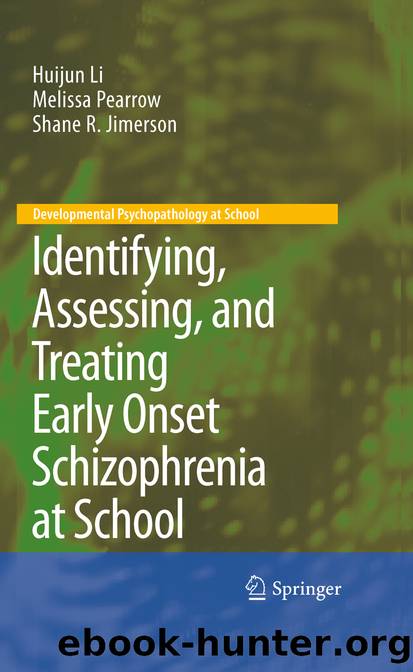Identifying, Assessing, and Treating Early Onset Schizophrenia at School by Huijun Li Melissa Pearrow & Shane R. Jimerson

Author:Huijun Li, Melissa Pearrow & Shane R. Jimerson
Language: eng
Format: epub
Publisher: Springer New York, New York, NY
Continuous (prominent psychotic symptoms are present throughout the period of observation); also specify if: With prominent negative symptoms
Single episode in partial remission; also specify if: With prominent negative symptoms
Single episode in full remission
Other or unspecified pattern
According to DSM-IV-TR, there are five schizophrenia subtypes: Paranoid Type, Disorganized Type, Catatonic Type, Undifferentiated Type, and Residual Type. Among the five subtypes, the Paranoid Subtype is regarded as the least severe and the Disorganized Subtype as the most severe (APA, 2000). The subtypes are also classified into three dimensional descriptors for current and lifetime symptomatology of schizophrenia – psychotic, disorganized, and negative dimensions. The psychotic dimension includes symptoms of delusions and hallucinations, which are also called positive symptoms. The disorganized dimension includes disorganized speech, disoriented behavior, and inappropriate affect. The negative dimension includes the aforementioned negative symptoms such as withdrawal, flat affect, avolition, or alogia. Based on the severity of a person’s symptoms, an absent, mild, moderate, or severe specification is assigned to each of the three dimensions for either or both the current episode (past 6 months) or/and the lifetime course of the disorder (APA, 2000).
Download
This site does not store any files on its server. We only index and link to content provided by other sites. Please contact the content providers to delete copyright contents if any and email us, we'll remove relevant links or contents immediately.
The Art of Coaching Workbook by Elena Aguilar(50754)
Trainspotting by Irvine Welsh(21440)
Twilight of the Idols With the Antichrist and Ecce Homo by Friedrich Nietzsche(18452)
Fangirl by Rainbow Rowell(9025)
Periodization Training for Sports by Tudor Bompa(8097)
Change Your Questions, Change Your Life by Marilee Adams(7565)
This Is How You Lose Her by Junot Diaz(6701)
Asking the Right Questions: A Guide to Critical Thinking by M. Neil Browne & Stuart M. Keeley(5577)
Grit by Angela Duckworth(5448)
Red Sparrow by Jason Matthews(5322)
Paper Towns by Green John(5023)
Room 212 by Kate Stewart(4963)
Ken Follett - World without end by Ken Follett(4596)
Housekeeping by Marilynne Robinson(4253)
The Sports Rules Book by Human Kinetics(4213)
Papillon (English) by Henri Charrière(4146)
Double Down (Diary of a Wimpy Kid Book 11) by Jeff Kinney(4145)
The Motorcycle Diaries by Ernesto Che Guevara(3933)
Exercise Technique Manual for Resistance Training by National Strength & Conditioning Association(3906)
